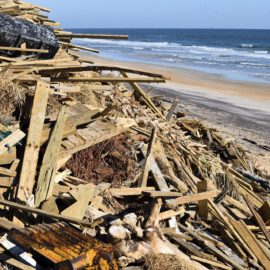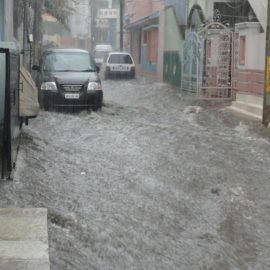
We know it is coming. We know most of us will get large increases. But will we slide by for a year? Signs are showing who will get hit and by how much.
Could flood insurance premiums rise by more than 450% in parts of New Orleans? Or nearly 900% in areas of Covington? Trying to figure out what premium you’ll eventually pay under sweeping changes to the nation’s flood insurance program has been akin to solving a puzzle with missing pieces. FEMA, which oversees the program, has been stingy with information. But clues have emerged in newly written insurance policies and research from the First Street Foundation nonprofit, which has developed its own flood risk model. Those clues suggest numbers such as the ones above could prove correct.
nola.com
Oh no! How can we afford it? Can the congressional delegation help?
Local officials in Louisiana and the state’s congressional delegation have been trying to raise awareness of the new flood insurance rates, warning that residents have been left in the dark about the magnitude of the increases they may face. They say that such steep premium hikes could devastate certain communities in south Louisiana, where everyone lives near water of some kind. FEMA has sought to reassure critics by describing the revamped program, known as Risk Rating 2.0, as fairer for everyone. It is designed to more accurately gauge the flood risk of each individual property and do away with a system where older, less expensive homes essentially subsidized premiums for beachside vacation houses. It also says that around 20% of Louisiana policyholders will see one-time decreases in the new system. But at the same time FEMA has only released figures on increases and decreases for the first year of Risk Rating 2.0, masking the full impact, since premiums will continue to rise well into the future for many. The concern is that parts of the housing market in Louisiana, which has the nation’s highest participation rate in the National Flood Insurance Program, will be dramatically reshaped by the changes.
I do not live on the shore. We have flooded once in 6 years and that was from rain not associated with a storm system. Why me?
Working-class families who bought homes based on cheap flood insurance rates could now face steep increases phased in over multiple years, adding significantly to their mortgage payments. Those buying new homes will have to pay the new rates immediately. The burden could be unmanageable for certain residents, parish leaders warn. St. Bernard Parish President Guy McInnis was perhaps the most blunt, calling the increases “stupidity.” There are also concerns over the effect the new rates will have on rebuilding in areas hit hard by Hurricane Ida. Realtors, insurers and property managers have had difficulty explaining the changes to clients. “It’s more like the trifecta of increases of insurance,” said Bill Soniat of Soniat Realty, which manages property in the New Orleans metro area and saw much of it flood in Hurricane Katrina. “It’s not just flood. It’s flood, property and a little bit on the liability side in our market.” Soniat said of the new flood insurance rates: “When people buy, it becomes an important question that people ask.”
Risk Rating 2.0. How can I tell what when all go up. Does that mean I grade on the percentage of increase? What are they grading on?
Risk Rating 2.0 began in October for new policies and April for existing ones. Existing policyholders will begin to see the change on their next renewal notice. For most current policies, increases are limited to 18% annually, meaning those seeing significant hikes will have them phased in over years. The compounded figures will add up to large numbers in some cases. Renewal notices will state the “full risk premium” – the target rate those 18% increases are moving toward. Since the new system is intended to more accurately price risk, an insightful clue on what that could mean is New York-based First Street Foundation’s “The Cost of Climate” analysis released last year. One element of the comprehensive analysis estimates current rates and compares them to what it calculates as average expected annual loss. The results are stark – and possibly frightening for some.
The analysis shows 10 Louisiana areas and what the increases are. New Orleans goes up 458%.
The analysis lists the 10 municipalities in Louisiana with the greatest difference between estimated average flood insurance premiums and average expected annual loss – in other words, the places where premiums now least reflect risk. Using its own model, it looked at residential properties considered to have substantial flood risk. That means properties in zones required to carry flood insurance, but also potentially some outside of it. Lacombe, parts of which sit next to Lake Pontchartrain and Bayou Lacombe, tops the list. According to the foundation, average estimated premiums for 2021 were $853, but average expected loss was $8,538 – a 901% difference. Covington, where the Bogue Falaya and Tchefuncte Rivers flow, comes in second with an 891% difference. The foundation lists average estimated premiums at $781 compared to $7,745 for average expected loss. Those are followed by LaPlace, Houma, Luling, Reserve, New Orleans, Eden Isles, Belle Chasse and Meraux. For New Orleans, average premium is listed as $577, while expected loss is put at $3,219 – a difference of 458%.
Now I am really confused. It says I pay a premium of $577 but my yearly cost is much higher. Is this my monthly or yearly premium as if is off the monthly premium and is compared to the total anticipated loss the percent would be larger.
The foundation’s Flood Factor website allows searches by address to determine risk. The Little Woods neighborhood of New Orleans East is found to be at particularly high risk, for example. Does that mean premiums for certain neighborhoods will definitely rise by that amount? Early returns suggest it’s possible. “Just given a purely risk-based approach, you would expect at some point the rates would start to approach what we’re showing in our model,” said the foundation’s Jeremy Porter. Separately, the foundation projects ahead 30 years to determine which communities will see the biggest increase in flood loss, taking into account climate change and sea level rise. Lake Charles is among the top 10 Louisiana communities in that category, with a projected 1,040% increase.
Enough for theoretics, lets look at concrete examples.
As for premium prices, there have already been concrete, real-world examples: One local homebuilder says his company is seeing policies increase from $650 per year to around $3,500 for houses in the $250,000 to $500,000 range, A man who lives near Boutte asked for a quote as if his house were newly built to have an idea of what he’ll be facing. The quote came back at $8,100 compared to the $567 he currently pays, A Houma resident saw a policy quoted for his new house at around $3,800 compared to the $575 he had been paying and Realtors and insurers report premiums quadrupling or more in some cases.
This is the first reevaluation in years and so it is a shock.
Risk Rating 2.0 marks the biggest change in how rates are set since the NFIP was created in 1968. It uses a complicated algorithm that relies on various databases, some of which are not public, to calculate the new rates. The old system relied heavily on FEMA’s maps. A range of factors are taken into account in the new system, including distance from water, construction type, elevation and rebuilding cost. But getting under the hood of how those calculations are made is impossible because aspects of the new system, developed with consulting firm Milliman, are not publicly available. There is widespread agreement on the goal of pricing risk accurately, both to inform residents of the dangers of where they have chosen to live as well as to help set the deeply indebted NFIP on a path to solvency. But it raises the question of whether the government should play a role in keeping flood insurance affordable for those who need it. Many point out that the federal levee failures during Hurricane Katrina, which resulted in a large chunk of the NFIP’s debt, were due to shoddy engineering rather than foolhardy decisions about where to live. Legislation has been proposed by Louisiana’s two senators, Bill Cassidy and John Kennedy, as well as U.S. Reps. Garret Graves, R-Baton Rouge, and Troy Carter, D-New Orleans, to address some of the concerns, but has so far not been approved. There are also questions about how much mitigation work such as elevating a home can reduce a premium. FEMA recently released a document seeking to further explain discounts available for such work, but it leaves lots of unanswered questions.
In other words, the more we know the less we know. And FEMA is not, apparently, being forthwith. Or does that mean they can’t explain it either?
Chad Berginnis, executive director of the Association of State Floodplain Managers, lauds the attempt to communicate the actual risk to homeowners as well as FEMA’s overhauling of the old map-based system, which was widely viewed as inadequate. He sees the new system as moving in the right direction, but says some important concerns must be addressed. Homeowners need a clear explanation of how they can mitigate their properties, and some form of aid should be offered to those who can’t afford the increases, said Berginnis. His organization has also advocated for automatic debt cancellation for the NFIP after catastrophic events. FEMA cannot institute financial assistance on its own. It needs Congress to approve that, which it so far has not done. Berginnis would also like to see FEMA release a tool that would allow residents to receive an estimated rate, with the option to plug in elevation heights and other factors to have an idea of how high they should build. “The problem is we don’t have a table or a manual anymore,” he said. “ We don’t have a tool that we can use to help advise people on the right way to not only be more resilient, but to reduce their rate.”
They can’t tell me why exactly it went up and they can’t tell me how to reduce it. Not a good way to run a railroad.



